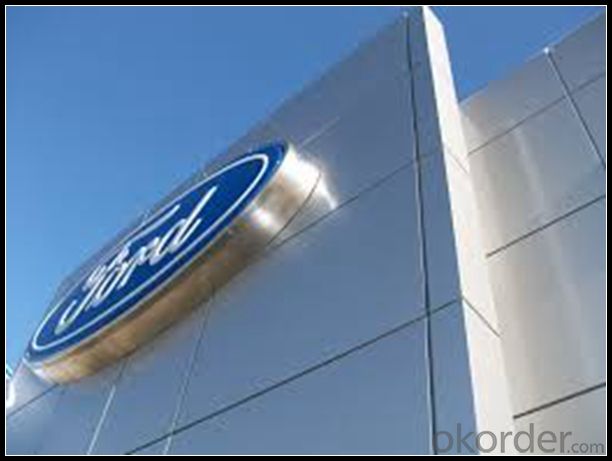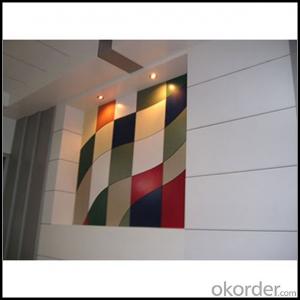Aluminum Roofing Panels Mill Finished Hot Rollsed
- Loading Port:
- Shanghai
- Payment Terms:
- TT OR LC
- Min Order Qty:
- 5 m.t.
- Supply Capability:
- 100000 m.t./month
OKorder Service Pledge
OKorder Financial Service
You Might Also Like
Item specifice
1.Structure of Aluminum Roofing Panels Mill Finished Hot Rollsed
Aluminum Sheets are strengthened and cut from raw materials with different alloys, such as AA5005, AA5052, etc. They are easy for processing in different shapes, good in intensity and can be quickly installed. Aluminium Sheets for Energy Saving Curtain Walls are good in energy saving, weather resistance, fire resistance, easy for maintenance and with many colors.
Aluminium Sheets for Energy Saving Curtain Walls are widely used in construction of metal walls, metal ceilings, car decoration, advertizing panels, etc.
2.Main Features of Aluminum Roofing Panels Mill Finished Hot Rollsed
•High intensity
•Easy to be processed and shaped
•Weather resistance
•Anti-pollution & environment protection
3. Aluminum Roofing Panels Mill Finished Hot Rollsed Images



4.Specification of Aluminum Roofing Panels Mill Finished Hot Rollsed
Alloy Number | AA5XXX |
Temper | H12, H14, H16, H18, H22, H24, H26, H32, HO, F |
Thickness | 0.1mm – 500mm |
Width | 10mm- 2200mm |
Standard | GB/T3880-2006, ASTM, ISO, EU standard |
5.FAQ
A.What about inspections to guarantee quality?
For each order for Aluminum Sheets with Mill Finished Surface AA5XXX, we will arrange strict inspection for raw materials, inspection during production and inspection for finished goods.
With requirement of customers, we also can arrange the third party inspection.
B.What about delivery?
We will put order for Aluminum Sheets with Mill Finished Surface AA5XXX in production schedule after order gets confirmed against copy of TT or L/C. Normally it takes about one month for production. Exact shipment schedule is different based on different sizes and quantity.
C.What is the MOQ?
5 tons for each size.
D. Where have you exported aluminium sheets?
We have exported aluminum sheets to many countries. Main markets include South East Asia, Middle East, North America, South America, etc.
- Q:Can aluminum sheets be used in electrical applications?
- Aluminum sheets have the capability to be employed in electrical applications. Due to its adeptness in conducting electricity, aluminum is frequently utilized in diverse electrical components and applications. In power transmission lines, bus bars, and electrical enclosures, aluminum sheets are frequently employed as conductive materials. Moreover, their exceptional thermal conductivity properties make them valuable in the production of capacitors, transformers, and heat sinks. Furthermore, aluminum sheets are lightweight and resistant to corrosion, rendering them appropriate for electrical applications where weight and durability are crucial considerations.
- Q:I'm working on a costume that's entirely made of cardboard (it's a giant robot), and I was wondering What's the best way to1 turn Soda cans into aluminum sheeting2: attach the aluminum everywhere on the robot3. Attach the aluminum to the aluminumThank you in advance.
- Why not heavy duty aluminum foil glued to cardboard? that would look a lot better than patched up pieces of aluminum from tin cans. How would you connect the chunks of aluminum together? and remove the label. Note that soda cans have a coating of plastic on the inside. I don't see any easy way to attach the bits of aluminum from tin cans together, and remove the painted on labels. It would look just like that, pieces of cans glued together. In stead of cardboard you could use foam board which is lighter and more rigid.
- Q:How does the thermal conductivity of aluminum compare to other metals?
- The thermal conductivity of aluminum is relatively high compared to many other metals. It is often considered one of the best conductors of heat among common metals. Aluminum has a thermal conductivity of about 205 watts per meter kelvin (W/m·K), which is higher than copper (about 401 W/m·K) and even silver (about 429 W/m·K). This means that aluminum can transfer heat more efficiently than most other metals, making it a popular choice for heat sinks, radiators, and other applications that require effective heat dissipation. However, it is worth noting that some metals, such as diamond and graphene, have even higher thermal conductivity than aluminum.
- Q:What is the typical elongation of aluminum sheets?
- The typical elongation of aluminum sheets can vary depending on the specific grade and temper of the aluminum being used. However, in general, aluminum sheets have a high elongation capacity compared to other metals. Elongation refers to the ability of a material to stretch or deform without breaking. Aluminum sheets typically have an elongation percentage ranging from 10% to 30%, which means they can be stretched by that percentage of their original length before reaching their breaking point. This high elongation capacity makes aluminum sheets highly versatile and suitable for various applications, such as in construction, automotive, aerospace, and manufacturing industries.
- Q:Could ring-pull can be transformed as aluminum sheet?
- Ring-pull cans will be reused after recycle, there are parts of ring-pull cans be transformed as aluminum sheet.
- Q:Are aluminum sheets suitable for automotive heat shields?
- Yes, aluminum sheets are suitable for automotive heat shields. Aluminum is a lightweight and highly conductive material, making it an excellent choice for heat management in automotive applications. It has a high melting point and good thermal conductivity properties, allowing it to effectively absorb and dissipate heat generated by the vehicle's engine, exhaust system, or other heat sources. Additionally, aluminum sheets are easy to shape and form into various sizes and designs, making them versatile for different automotive heat shield applications. Overall, aluminum sheets provide a cost-effective and efficient solution for protecting sensitive components from heat damage in automotive systems.
- Q:What are the different methods of surface cleaning aluminum sheets?
- There are several different methods for surface cleaning aluminum sheets, including chemical cleaning, mechanical cleaning, and electrolytic cleaning. Chemical cleaning involves using solutions or acids to remove dirt, oxidation, or other contaminants from the surface of the aluminum. Mechanical cleaning involves scrubbing or abrasive techniques to physically remove dirt or grime from the surface. Electrolytic cleaning utilizes an electric current and an electrolyte solution to remove contaminants and create a clean surface on the aluminum sheets.
- Q:Can aluminum sheets be used for packaging?
- Yes, aluminum sheets can be used for packaging. Aluminum is a versatile and widely used material in the packaging industry due to its numerous advantageous properties. It is lightweight, strong, durable, and resistant to corrosion, making it an ideal choice for packaging applications. Aluminum sheets can be easily formed into various shapes and sizes, providing flexibility in design and customization. Additionally, aluminum is impermeable to light, moisture, gases, and microorganisms, ensuring the preservation and protection of the packaged goods. It is also a good conductor of heat, which allows for efficient heat transfer during processes like sterilization or pasteurization. Furthermore, aluminum is recyclable, making it an environmentally friendly packaging option. Overall, aluminum sheets are an excellent choice for packaging due to their excellent properties and versatility.
- Q:Our production needs a large number of plating aluminum plate, consult domestic and imported aluminum plate difference?
- Let's fix it for you. We can't do the coil. We do hot plated pure aluminum steel plate
- Q:What are the different methods of surface etching for aluminum sheets?
- Aluminum sheets can be surface etched using various methods, each offering unique benefits and applications. Some commonly used methods include: 1. Chemical etching: This technique involves selectively removing a thin layer of aluminum from the surface using a chemical solution. The solution typically contains acids or alkaline substances that dissolve the metal, resulting in a textured or patterned surface. Chemical etching is ideal for decorative or aesthetic purposes due to its precision and ability to achieve intricate designs. 2. Mechanical etching: Also known as abrasive blasting or sanding, this method physically removes the top layer of aluminum using abrasive materials like sandpaper or wire brushes. It can be done manually or with the help of machinery and is commonly used to create a uniform matte finish or prepare the surface for painting or coating. 3. Electrochemical etching: In this method, an electrical current is used to selectively dissolve the aluminum surface. The aluminum sheet is immersed in an electrolyte solution, and a direct current is applied through a stencil or mask to create the desired pattern. Electrochemical etching is commonly employed for marking or labeling on aluminum sheets, as it produces clear, permanent, and highly precise designs. 4. Laser etching: Laser etching involves using a high-powered laser to permanently remove the top layer of aluminum, creating precise patterns on the surface. This method is highly accurate and capable of achieving intricate designs with sharp edges. Industrial applications, such as marking serial numbers, logos, or barcodes on aluminum sheets, commonly utilize laser etching. 5. Photochemical etching: This technique employs a photosensitive material, called a photoresist, to create patterns on the aluminum surface. The aluminum sheet is coated with the photoresist, exposed to UV light through a stencil or mask, and then developed to remove the unexposed areas. The exposed aluminum is subsequently etched away using a chemical solution. Photochemical etching is frequently used for producing high-resolution designs or microstructures on aluminum sheets. When selecting the appropriate surface etching method for aluminum sheets, it is essential to consider factors such as precision, speed, cost, and complexity, as each method has its own advantages depending on the desired outcome and application.
1. Manufacturer Overview |
|
|---|---|
| Location | |
| Year Established | |
| Annual Output Value | |
| Main Markets | |
| Company Certifications | |
2. Manufacturer Certificates |
|
|---|---|
| a) Certification Name | |
| Range | |
| Reference | |
| Validity Period | |
3. Manufacturer Capability |
|
|---|---|
| a)Trade Capacity | |
| Nearest Port | |
| Export Percentage | |
| No.of Employees in Trade Department | |
| Language Spoken: | |
| b)Factory Information | |
| Factory Size: | |
| No. of Production Lines | |
| Contract Manufacturing | |
| Product Price Range | |
Send your message to us
Aluminum Roofing Panels Mill Finished Hot Rollsed
- Loading Port:
- Shanghai
- Payment Terms:
- TT OR LC
- Min Order Qty:
- 5 m.t.
- Supply Capability:
- 100000 m.t./month
OKorder Service Pledge
OKorder Financial Service
Similar products
New products
Hot products
Related keywords




























